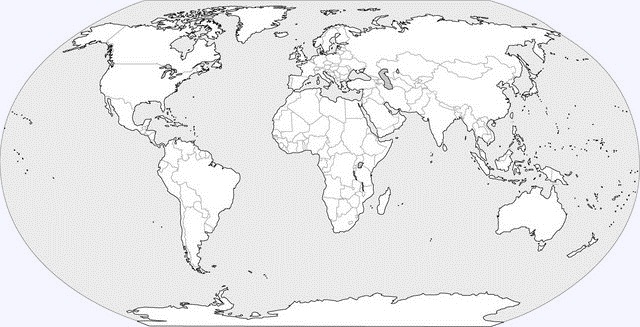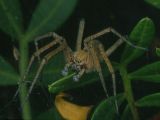|
Nombre común en ingles:
Wafer-lid trapdoor
spiders
Nombre común en castellano:
Se desconoce
Familias similares:
Género tipo:
Cyrtauchenius Thorell, 1869
Diagnosis:
Medium-sized to very large
mygalomorph spiders; three tarsal claws; eight eyes; rastellum
present; four spinnerets; paired claws usually biserially dentate in
females; tarsi I and II with scopula; front legs often shorter and
thicker than leg IV; male palp with distal sclerite an entire cone,
with a small median haematodocha.
Caracteres descriptivos:
Caparazón: glabrous; cephalic region raised; fovea
broad pro- or recurved. Esternón: with three pairs of sigilla.
Ojos: eight; in two rows, forming a rectangular group
or slightly wider hehind than in front; eye tubercle present
or absent. Quelíceros: cheliceral furrow with teeth on one or
both margins; rastellum distinct, reduced or absent;
rastellar mound present in all genera. Piezas bucales: endites rectangular or broad with few
cuspules; labium either wider than long or as wide as long,
with or without cuspules. Patas: three claws; tarsi I scopulate in females,
with few spines; all tarsi scopulate in males, or only
sparsely scopulate on tarsi I and II: anterior paired tarsal
claw biserially dentate in females or with one large
bicuspid tooth; teeth arranged in an S-shaped row in males;
front legs often shorter and thicker than leg IV; preening
comb on leg IV present or absent. Palpo femenino: unmodified.
Abdomen: oval; dorsum with pattern in some species. Hileras: four; apical segment of posterior spinnerets
either domed or triangular. Sistema respiratorio: cuatro filotráqueas.
Genitalia: spermathecae multilobular; male palp
simple; femur sometimes with spur, bulbus pyriform; medial
haematodocha small, without conductor; cymbium simple. Tamaño corporal: 9-32 mm.
Color: varies from dark chestnut-brown to reddish
yellow.
Estatus taxonómico:
The family belong to the Rastelloidina and is the sister-group of
Domiothelina structured as (((Migidae, Actinopodidae) Ctenizidae)
Idiopidae) (Raven, 1985). Raven (1985) provided a key to the genera
of the world. Some genera were recently revised (Bond & Opell, 2002;
Raven & Schwndinger, 1995).
Distribución: North,
Central and South America, southern Europe, Africa, Australia and
southeast Asia.

Estilo de vida: Live in
silk-lined burrows made in the soil and closed with wafer-lid
trapdoors.
Bibliografía:
-
Bond, J.A. & Hendrixson, B.E. 2005. Ctenizidae. pp. 43-44 in Ubick,
D., Paquin, P., Cushing, P.E. & Roth, V. (Eds) 2005. The Spiders of
North America. An Identification Manual. American Arachnological
Society.
-
Bond, J.E. & Opell, B.D. 2002. Phylogeny and taxonomy of the genera
of south-western North American Euctenizinae trapdoor spiders and
their relatives (Araneae: Mygalomorphae: Cyrtaucheniidae). Zool. J.
Linn. Soc. 136: 487-534.
-
Dippenaar-Schoeman, A.S. & Jocqué, R. 1997. African Spiders: An
Identification Manual. Plant Protection Res. Inst. Handbook, no. 9,
Pretoria, 392 pp.
-
Dippenaar- Schoeman, A.S. 2002. Baboon and trapdoor spiders of
southern Africa: An identification manual. Plant Protection Res.
Inst. Handbook, no. 13, Agricultural Research Council, Pretoria, 128
pp.
-
Raven, R.J. 1985. The spider infraorder Mygalomorphae (Araneae):
Cladistics and systematics. Bull. Am. Mus. Nat. Hist. 182: 1-180.
-
Raven, R.J. & Schwendinger, P.J. 1995. Three new mygalomorph spider
genera from Thailand and China (Araneae). Mem. Qd Mus. 38: 623-641.
1 género y 1 especie presentes en la Península Ibérica:
|
| |
- C.
walckenaeri
(Lucas, 1846) |
| |
|
 |